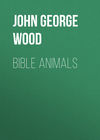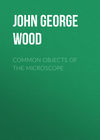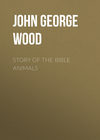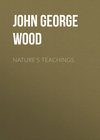Czytaj książkę: «Bible Animals», strona 41
It is not unlikely that the word Leviathan also signified any of the larger inhabitants of the waters, whether marine or reptile, and that a whale or a Crocodile would be equally called by that name. In this sense we must interpret the well-known passage, Ps. civ. 24-26:
"O Lord, how manifold are Thy works! in wisdom hast Thou made them all: the earth is full of Thy riches.
"So is this great and wide sea" (i.e. the Mediterranean), "wherein are things creeping innumerable, both small and great beasts.
"There go the ships: there is that Leviathan, whom Thou hast made to play therein." In this passage the writer points to some large inhabitant of the Mediterranean, or the Great Sea, as it is called in Scripture, to distinguish it from the Sea of Galilee, and the only creature which would answer to the allusion must be one of the larger cetacean.
We also find that the Crocodile must be signified by the Hebrew word tannin, which occurs in several parts of Scripture, and which is sometimes translated as "dragon," and sometimes as "serpent," and sometimes as "whale." For example, in Exod. vii. 10, we find the well-known passage which relates the changing of Aaron's rod into a Tannin, or serpent, as the Authorized Version translates it. The Jewish Bible, however, simply renders the word as "huge creature." Next, we come to Deut. xxxii. 33: "Their wine is the poison of dragons, and the cruel venom of asps." This passage is rendered in the Jewish Bible as "Their wine is the fury of huge creatures, and the cruel venom [or head] of asps."
The same word occurs in Job vii. 12: "Am I a sea, or a whale [tannin], that thou settest a watch over me?" We also find it in Jer. ix. 11: "And I will make Jerusalem heaps, and a den of dragons [tannin];" and the same image is repeated in x. 22: "Behold, the noise of the bruit is come, and a great commotion out of the north country, to make the cities of Judah desolate, and a den of dragons." The same prophet again repeats the word in xiv. 6: "The wild asses did stand in the high places, they snuffed up the wind like dragons."
There is nothing in any of these passages which would give any clue as to the creature that was signified by the word tannin, but we obtain a clue to it in Ezek. xxix. 2-5: "Son of man, set thy face against Pharaoh king of Egypt, and prophesy against him, and against all Egypt:
"Speak, and say, Thus saith the Lord God, Behold, I am against thee, Pharaoh king of Egypt, the great dragon that lieth in the midst of his rivers, which hath said, My river is mine own, and I have made it for myself.
"But I will put hooks in thy jaws, and T will cause the fish of thy rivers to stick unto thy scales; and I will bring thee up out of the midst of thy rivers, and all the fish of thy rivers shall stick unto thy scales.
"And I will leave thee thrown into the wilderness, thee and all the fish of thy rivers: thou shalt fall upon the open fields; thou shalt not be brought together nor gathered: I have given thee for meat to the beasts of the field, and to the fowls of the heaven."
See also xxxii. 2, 3: "Son of man, take up a lamentation for Pharaoh king of Egypt, and say unto him, Thou art like a young lion of the nations, and thou art as a whale [tannin] in the seas; and thou camest forth with thy rivers, and troubledst the waters with thy feet, and fouledst their rivers.
"Thus saith the Lord God, I will therefore spread out my net over thee with a company of many people; and they shall bring thee up in my net."
There is a peculiar significance in the comparison of Pharaoh to the Crocodile. It is the master and terror of the Nile, of whom all animals stand in fear. It is ravenous, crafty, fierce, and relentless, keen-eyed to espy prey, and swift to devour it. Yet, in spite of all these evil qualities, the Egyptians venerated it, pampered it, hung it with costly jewels, and paid divine honours to it, exactly as they considered their despotic sovereign as a demigod during his life, and honoured him with an apotheosis after his death.
Like the Crocodile, secure in his scaly armour, Pharaoh thought himself invincible, but, though man could not conquer him, God could do so. Man could not "put a hook into his nose, or bore his jaws through with a thorn" (Job xli. 2); but the Lord could "put hooks in his jaws, and bring him up out of the midst of his rivers, and give him for meat to the beasts of the field and the fowls of the heaven."
Taking also the Tannin of Exod. vii. to be the Crocodile, we see how appropriate were all the circumstances. The miracle was performed in the presence of Pharaoh, who is afterwards spoken of under the emblem of the "dragon (tannin) that lieth in the midst of the river." The rod of the future high priest of the Lord was changed into the Crocodile, which was worshipped by the Egyptian priests and magicians; and when they imitated the miracle, Aaron's rod swallowed up those of the heathen in token that the Lord would destroy idolatry.
It is worthy of mention here that, although in the Authorized Version of the Scriptures, the rods of both Moses and Aaron are mentioned as having been changed into serpents, the words which are translated as serpents are different. The rod of Aaron, the priest, was turned into a Tannin, i.e. Crocodile; that of Moses, the lawgiver, into a Nachash or serpent.
There is one passage which seems to imply that the word tannin may signify a cetacean. It occurs in Lam. iv. 3: "Even the sea-monsters [tannin] draw out the breast, they give suck to their young ones." If the sacred writers were aware that the cetaceans were mammals and suckled their young, and that the Crocodile left its offspring to find food for themselves, there would be no doubt on the subject. But it is not at all likely that the Prophet Jeremiah, his soul torn by the crimes of his country and the calamities which he foresaw, persecuted by his own people, his life endangered by the forebodings that he was compelled to utter, imprisoned, exiled, and at last dying in a strange land, would have been versed in natural history, or would have troubled himself to inquire as to the manner in which the young of the Crocodile were fed. The sense of the passage is plain enough, and contains a rebuke to the people in that they neglect their children, and were worse than the ferocious inhabitants of the water, as we shall see on reading the whole of the passage: "Even the sea-monster draws out the breast; they give suck to their young ones: the daughter of my people is become cruel, like the ostriches in the wilderness.
"The tongue of the sucking child cleaveth to the roof of his mouth for thirst; the young children ask bread, and no man breaketh it unto them."
THE LETÂÂH OR LIZARD
Difficulty of identifying the Letââh—Probability that it is a collective and not a specific term—Various Lizards of Palestine—The Green or Jersey Lizard—The Cyprius, its appearance and habits—The Glass Snake or Scheltopusic—Translation of the word chomet—Probability that it signifies the Skink—Medicinal uses of the Lizard—The Seps tribe—The common Cicigna, and the popular belief concerning its habits—The Sphænops and its shallow tunnel.
In Leviticus xi. 30, the word Lizard is used as the rendering of the Hebrew word letââh (pronounced as L'tâh-âh). There are one or two difficulties about the word, but, without going into the question of etymology, which is beside the object of this work, it will be sufficient to state that the best authorities accept the rendering, and that in the Jewish Bible the word Lizard is retained, but with the mark of doubt appended to it.
In all probability, the sacred lawgiver employs the word letââh as a general term; so that, although he prohibits certain Lizards by name, as having been used for food by the various nations with whom the Israelites were necessarily brought in contact during their captivity, their wanderings, and their final conquest of Palestine, he implies that the whole of the Lizard tribe are to be considered as unfit to be eaten by the chosen people.
We shall presently examine some of those which are prohibited by name, and it will be sufficient in the present case to glance at the Lizard tribes of Egypt, Palestine, and Syria.
These lands absolutely swarm with Lizards. Even in our own country, Lizards are far more common than is generally known. I have caused the greatest surprise in an agricultural county by catching and showing to the field-labourers the common Scaly Lizard (Zootoca vivipara). The little reptile was exceedingly plentiful, and yet not one of the labourers, nor even their employers, had seen it.
In warmer parts of the earth, the Lizards are so numerous and so comparatively large that they force themselves upon the notice. For example, the well-known Green or Jersey Lizard (Lacerta viridis) is exceedingly plentiful, and may be seen darting among the leaves in search of prey, after the erratic manner of Lizards generally, which will remain absolutely motionless for hours together, then whisk about so rapidly that the eye can scarcely follow their movements, and subside into quiescence as suddenly as they started from it.

THE CYPRIUS, OR LIZARD OF SCRIPTURE.
"And the ferret, and the chameleon, and the lizard, and the snail, and the mole."—Levit. xi. 30.
In many parts of the world, especially in France, where the terror inspired by nearly all reptiles is really ludicrous, this beautiful and harmless creature is feared as if it were a venomous serpent, and, to judge from experience, I doubt whether a cobra or a rattlesnake would excite more horror than a Green Lizard.
A very common species of Lizard, and therefore likely to be one of those which are grouped under the common name of Letââh, is the Cyprius (Plestiodon auratum). This handsome Lizard is golden-yellow in colour, beautifully spotted with orange and scarlet, and may be distinguished, even when the colours have fled after death, by the curiously formed ears, which are strongly toothed in front. It is very plentiful in Palestine, and, like others of its kin, avoids cultivated tracts, and is generally found on rocky and sandy soil which cannot be tilled. It is active, and, if alarmed, hides itself quickly in the sand or under stones.
It belongs to the great family of the Skinks, many of which, like the familiar blind-worm of our own country, are without external legs, and, though true Lizards, progress in a snake-like manner, and are generally mistaken for snakes. One of these is the Glass Snake or Scheltopusic (Pseudopus pallasii), which has two very tiny hind legs, but which is altogether so snake-like that it is considered by the natives to be really a serpent. They may well be excused for their error, as the only external indications of limbs are a pair of slightly-projecting scales at the place where the hind legs would be in a fully-developed Lizard.
Though tolerably plentiful, the Scheltopusic is not very often seen, as it is timid and wary, and, when it suspects danger, glides away silently into some place of safety. When adult, the colour of this Lizard is usually chestnut, profusely mottled with black or deep brown, the edge of each scale being of the darker colour. It feeds upon insects and small reptiles, and has been known to devour a nest full of young birds.
In Levit. xi. 30 is a Hebrew word, chomet, which is given in the Authorized Version as Snail. There is, however, no doubt that the word is wrongly translated, and that by it some species of Lizard is signified. The Jewish Bible follows the Authorized Version, but affixes the mark of doubt to the word. There is another word, shablul, which undoubtedly does signify the snail, and will be mentioned in its proper place.
It is most probable that the word chomet includes, among other Lizards, many of the smaller Skinks which inhabit Palestine. Among them we may take as an example the Common Skink (Scincus officinalis), a reptile which derives its specific name from the fact that it was formerly used in medicine, together with mummy, and the other disgusting ingredients which formed the greater part of the old Pharmacopœia.
Even at the present day, it is used for similar purposes in the East, and is in consequence captured for the use of physicians, the body being simply dried in the sun, and then sent to market for sale. It is principally employed for the cure of sunstroke, nettle-rash, sand-blindness, or fever, and both patient and physician have the greatest confidence in its powers. It is said by some European physicians that the flesh of the Skink really does possess medicinal powers, and that it has fallen into disrepute chiefly because those powers have been exaggerated. In former days, the head and feet were thought to possess the greatest efficacy, and were valued accordingly.
Like all its tribe, the Skink loves sandy localities, the soil exactly suiting its peculiar habits. Although tolerably active, it does not run so fast or so far as many other Lizards, and, when alarmed, it has a peculiar faculty for sinking itself almost instantaneously under the sand, much after the fashion of the shore-crabs of our own country. Indeed, it is even more expeditious than the crab, which occupies some little time in burrowing under the wet and yielding sand, whereas the Skink slips beneath the dry and comparatively hard sand with such rapidity that it seems rather to be diving into a nearly excavated burrow than to be scooping a hollow for itself.
The sand is therefore a place of safety to the Skink, which does not, like the crab, content itself with merely burying its body just below the surface, but continues to burrow, sinking itself in a few seconds to the depth of nearly a yard.
The length of the Skink is about eight inches, and its very variable colour is generally yellowish brown, crossed with several dark bands. Several specimens, however, are spotted instead of banded with brown, while some are banded with white, and others are spotted with white. In all, however, the under-surface is silver grey.
It has been thought by several zoologists, that several of the Lizards belonging to the Seps family may be included in the general term of Chomet.
This theory is strengthened by the fact that those of the Sepsidæ which have no visible feet, and which, after the custom of such Lizards, burrow in the sand, are even at the present day eaten by Arabs, under the convenient title of Sand-fishes.
Several species of the Sepsidæ inhabit Egypt, Palestine, and Syria, and of these we will take two as examples.
The first is the Common Seps or Cicigna (Seps tridactylis), a nearly legless Lizard, having a very long and snake-like body, and four legs, so small and feeble as to be of scarcely any use in locomotion.
It bears some resemblance to the blindworm of England, feeds on much the same diet, and has similar habits. It is perfectly harmless, its teeth being too small, and its jaws too feeble, to hurt any creature larger than those on which it feeds; but, like the blindworm, it is much dreaded by the ignorant, who believe that it steals upon horses and other cattle by night, and bites them as they sleep.
Like other Lizards of its kind, it is one of the sand-lovers, burying itself when it suspects danger.
The second example of the Sepsidæ is one that has its chief home in Egypt. This is the Capistrated Sphænops (Sphænops sepsoides). This reptile is also a burrower, but does not sink so deeply into the sand as those Lizards which have just been noticed. Indeed, it scarcely burrows deeply enough to cover it, so that with the foot the sand may be scraped off, and the reptile discovered.
Sometimes it has recourse to a substitute for a tunnel, and will crawl along the deep rut made by a cart-wheel rather than take the trouble of excavating a passage for itself. In consequence of this peculiarity, it may generally be found in any ridged ground, such as that which is employed in the cultivation of rice and other grain, and, as it prefers to follow the course of the ridges rather than leave them, it may be taken without much trouble. It is perfectly harmless, and, although when taken it struggles violently to escape, it never employs its teeth on the hand that holds it. The colour of the Sphænops is pale brown, diversified with a black stripe on either side of the muzzle, and a longitudinal series of black dots along the body. The tail is conical and pointed.
THE CHAMELEON, MONITOR, AND GECKO
Translation of the word Koach—Signification of the word, and its applicability to the Chameleon—Power of the reptile's grasp—The prehensile tail—Demeanour of the Chameleon on the ground—The independent eyes—Its frequent change of colour—Mode of taking prey—Strange notions respecting the Chameleon—The Monitor, or Land Crocodile—Its habits and use to mankind—The Nilotic Monitor, and its habit of destroying the eggs and young of the Crocodile—The Gecko or Ferret of Scripture.
In Levit. xi. 30 there occurs a word which has caused great trouble to commentators. The word is koach (pronounced as a dissyllable thus, ko-ach). Primarily, it signifies power and strength, but in this passage it signifies the name of some creature which is included in the list of unclean beasts. There is very little doubt that it signifies some species of lizard, and in the Authorized Version it is rendered as Chameleon. The Jewish Bible accepts the same translation, but appends to it the mark of doubt.
There are two lizards to which the term may possibly be applied—namely, the Chameleon and the Monitor; and, as the Authorized Version of the Scriptures accepts the former interpretation, we will first describe the Chameleon.
This reptile is very plentiful in the Holy Land, as well as in Egypt, so that the Israelites would be perfectly familiar with it, both during their captivity and after their escape. It is but a small reptile, and the reader may well ask why a name denoting strength should be given to it. I think that we may find the reason for its name in the extraordinary power of its grasp, as it is able, by means of its peculiarly-formed feet and prehensile tail, to grasp the branches so tightly that it can scarcely be removed without damage.
I once saw six or seven Chameleons huddled up together, all having clasped each other's legs and tails so firmly that they formed a bundle that might be rolled along the ground without being broken up. In order to show the extraordinary power of the Chameleon's grasp, I have had a figure drawn from a sketch taken by myself from a specimen which I kept for several months.

GECKO AND CHAMELEON.
"And the ferret, and the chameleon, and the lizard, and the snail, and the mole."—Levit. xi. 30.
When the Chameleon wished to pass from one branch to another, it used to hold firmly to the branch by the tail and one hind-foot, and stretch out its body nearly horizontally, feeling about with the other three feet, as if in search of a convenient resting-place. In this curious attitude it would remain for a considerable time, apparently suffering no inconvenience, though even the spider-monkey would have been unable to maintain such an attitude for half the length of time.
The strength of the grasp is really astonishing when contrasted with the size of the reptile, as any one will find who allows the Chameleon to grasp his finger, or who tries to detach it from the branch to which it is clinging. The feet are most curiously made. They are furnished with five toes, which are arranged like those of parrots and other climbing birds, so as to close upon each other like the thumb and finger of a human hand. They are armed with little yellow claws, slightly curved and very sharp, and when they grasp the skin of the hand they give it an unpleasantly sharp pinch.
The tail is as prehensile as that of the spider-monkey, to which the Chameleon bears a curious resemblance in some of its attitudes, though nothing can be more different than the volatile, inquisitive, restless disposition of the spider-monkey and the staid, sober demeanour of the Chameleon. The reptile has the power of guiding the tail to any object as correctly as if there were an eye at the end of the tail. When it has been travelling over the branches of trees, I have often seen it direct its tail to a projecting bud, and grasp it as firmly as if the bud had been before and not behind it.
Sometimes, when it rests on a branch, it allows the tail to hang down as a sort of balance, the tip coiling and uncoiling unceasingly. But, as soon as the reptile wishes to move, the tail is tightened to the branch, and at once coiled round it. There really seems to be almost a separate vitality and consciousness on the part of the tail, which glides round an object as if it were acting with entire independence of its owner.
On the ground the Chameleon fares but poorly. Its walk is absolutely ludicrous, and an experienced person might easily fail to identify a Chameleon when walking with the same animal on a branch. It certainly scrambles along at a tolerable rate, but it is absurdly awkward, its legs sprawling widely on either side, and its feet grasping futilely at every step. The tail, which is usually so lithe and nimble, is then held stiffly from the body, with a slight curve upwards.
The eyes are strange objects, projecting far from the head, and each acting quite independently of the other, so that one eye may often be directed forwards, and the other backwards. The eyeballs are covered with a thick wrinkled skin, except a small aperture at the tip, which can be opened and closed like our own eyelids.
The changing colour of the Chameleon has been long known, though there are many mistaken ideas concerning it.
The reptile does not necessarily assume the colour of any object on which it is placed, but sometimes takes a totally different colour. Thus, if my Chameleon happened to come upon any scarlet substance, the colour immediately became black, covered with innumerable circular spots of light yellow. The change was so instantaneous that, as it crawled on the scarlet cloth, the colour would alter, and the fore-part of the body would be covered with yellow spots, while the hinder parts retained their dull black. Scarlet always annoyed the Chameleon, and it tried to escape whenever it found itself near any substance of the obnoxious hue.
The normal colour was undoubtedly black, with a slight tinge of grey. But in a short time the whole creature would become a vivid verdigris green, and, while the spectator was watching it, the legs would become banded with rings of bright yellow, and spots and streaks of the same colour would appear on the head and body.
When it was excited either by anger or by expectation—as, for example, when it heard a large fly buzzing near it—the colours were singularly beautiful, almost exactly resembling in hue and arrangement those of the jaguar. Of all the colours, green seemed generally to predominate, but the creature would pass so rapidly from one colour to another that it was scarcely possible to follow the various gradations of hue.
Some persons have imagined that the variation of colour depends on the wants and passions of the animal. This is not the case. The change is often caused by mental emotion, but is not dependent on it; and I believe that the animal has no control whatever over its colour. The best proof of this assertion may be found in the fact that my own Chameleon changed colour several times after its death; and, indeed, as long as I had the dead body before me, changes of hue were taking place.
The food of the Chameleon consists of insects, mostly flies, which it catches by means of its tongue, which can be protruded to an astonishing distance. The tongue is nearly cylindrical, and is furnished at the tip with a slight cavity, which is filled with a very glutinous secretion. When the Chameleon sees a fly or other insect, it gently protrudes the tongue once or twice, as if taking aim, like a billiard-player with his cue, and then, with a moderately smart stroke, carries off the insect on the glutinous tip of the tongue. The force with which the Chameleon strikes is really wonderful. My own specimen used to look for flies from my hand, and at first I was as much surprised with the force of the blow struck by the tongue as I was with the grasping power of the feet.
Among the wild legends with which the earlier naturalists adorned their accounts of all animals with which they were not personally familiar, those of the Chameleon are not the least curious. "Themselves," writes Topsel, an author of the sixteenth century, "are very gentle, never exasperated but when they are about wilde fig-trees.
"They have for their enemies the serpent, the crow, and the hawk. When the hungry serpent doth assault them, they defend themselves in this manner, as Alexander Mindius writeth. They take in their mouths a broad and strong stalk, under protection of which, as under a buckler, they defend themselves against their enemy the serpent, by reason that the stalk is broader than the serpent can gripe in his mouth, and the other parts of the chamæleon so firm and hard as the serpent cannot hurt them: he laboureth but in vain to get a prey, so long as the stalk is in the chamæleon's mouth.
"But if the chamæleon at any time see a serpent taking the air, and sunning himself under some green tree, he climbeth up into that tree, and setteth himself directly over the serpent; then out of his mouth he casteth a thread, like a spider, at the end of which hangeth a drop of poyson as bright as any pearl; by this string he letteth down the poyson upon the serpent, which, lighting upon it, killeth it immediately.
"And Scaliger reporteth a greater wonder than this in the description of the chamæleon; for he saith, if the boughs of the tree so grow as the perpendicular line cannot fall directly upon the serpent, then he so correcteth and guideth it with his fore-feet that it falleth upon the serpent within the mark of a hair's breadth.
"The raven and the crow are also at variance with the chamæleon, and so great is the adverse nature betwixt these twain, that if the crow eat of the chamæleon being slain by him, he dyeth for it except he recover his life by a bay-leaf, even as the elephant, after he hath devoured a chamæleon, saveth his life by eating of the wilde olive-tree.
"But the greatest wonder of all is the hostility which Pliny reporteth to be betwixt the chamæleon and the hawk. For he writeth that when a hawk flyeth over a chamæleon, she hath no power to resist the chamæleon, but falleth down before it, yeelding both her life and her limbs to be devoured by it, and thus that devourer that liveth upon the prey and blood of others hath no power to save her own life from this little beast."
It may here be remarked that the frog was said to save itself from the water-ducks by seizing a stick crosswise in its mouth, so that when the duck came to seize its prey, the stick came across the angles of the jaws, and prevented the frog from being swallowed.
So much for the Chameleon. We will now take the Nilotic Monitor (Hydrosaurus niloticus) and the Land Monitor (Psammosaurus scincus), the other reptiles which have been conjectured to be the real representatives of the Koach.
These lizards attain to some size, the former sometimes measuring six feet in length, and the latter but a foot or so less. Of the two, the Land Monitor, being the more common, both in Palestine and Egypt, has perhaps the best claim to be considered as the Koach of Scripture. It is sometimes called the Land Crocodile. It is a carnivorous animal, feeding upon other reptiles and the smaller mammalia, and is very fond of the eggs of the crocodile, which it destroys in great numbers, and is in consequence much venerated by the inhabitants of the country about the Nile.
The theory that this reptile may be the Koach of Leviticus is strengthened by the fact that even at the present day it is cooked and eaten by the natives, whereas the chameleon is so small and bony that scarcely any one would take the trouble of cooking it.
The Nilotic Monitor shares the same habit of devouring crocodiles' eggs, and consequently shares the respect of those who are endangered by the crocodile. It even eats the young crocodiles after they are hatched, chasing them through the water, and capturing them by means of its superior swiftness. It may be distinguished from the Land Monitor by the elevated keel which runs along the whole of the spine from the neck to the very end of the long tail. The general colour of the Nilotic Monitor is olive-grey, mottled with black. On the back of the neck are a series of curved bands of a whitish yellow.
It is mentioned on page 69, that the word anâkah, which is translated as "ferret" in Levit. xi. 30, is certainly a lizard, and in all probability is one of the Geckos. I have therefore introduced into the same illustration on page 535 the commonest species of Gecko found in Palestine. The reader will observe the flat, fan-like expansions at the ends of the toes, by which it is able to adhere to flat surfaces.















